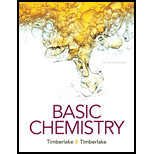
(a)
Interpretation:
Classify the following as a combination, decomposition, single replacement, double replacement, or combustion reaction:
Concept Introduction:
In a combustion reaction a hydrocarbon burns in the presence of oxygen to form carbon dioxide and water vapor.
In the decomposition reaction a complex compound breaks into simple elements.
In single replacement reaction one element replaces another element in a compound.
In a double displacement reaction the cation of one ionic compound is replaced by the cation of another ionic compound. Similarly, the anion of one ionic compound is replaced by the anion of another ionic compound.
(b)
Interpretation:
Classify the following as a combination, decomposition, single replacement, double replacement, or combustion reaction:
Concept Introduction:
Chemical reactions are of different types: In the combination reaction simple elements combine to form a complex compound.
In a combustion reaction a hydrocarbon burns in the presence of oxygen to form carbon dioxide and water vapor.
In the decomposition reaction a complex compound breaks into simple elements.
In single replacement reaction one element replaces another element in a compound.
In a double displacement reaction the cation of one ionic compound is replaced by the cation of another ionic compound. Similarly, the anion of one ionic compound is replaced by the anion of another ionic compound.
(c)
Interpretation:
Classify the following as a combination, decomposition, single replacement, double replacement, or combustion reaction:
Concept Introduction:
Chemical reactions are of different types: In the combination reaction simple elements combine to form a complex compound.
In a combustion reaction a hydrocarbon burns in the presence of oxygen to form carbon dioxide and water vapor.
In the decomposition reaction a complex compound breaks into simple elements.
In single replacement reaction one element replaces another element in a compound.
In a double displacement reaction the cation of one ionic compound is replaced by the cation of another ionic compound. Similarly, the anion of one ionic compound is replaced by the anion of another ionic compound.
(d)
Interpretation:
Classify the following as a combination, decomposition, single replacement, double replacement, or combustion reaction:
Concept Introduction:
Chemical reactions are of different types: In the combination reaction simple elements combine to form a complex compound.
In a combustion reaction a hydrocarbon burns in the presence of oxygen to form carbon dioxide and water vapor.
In the decomposition reaction a complex compound breaks into simple elements.
In single replacement reaction one element replaces another element in a compound.
In a double displacement reaction the cation of one ionic compound is replaced by the cation of another ionic compound. Similarly, the anion of one ionic compound is replaced by the anion of another ionic compound.
(e)
Interpretation:
Classify the following as a combination, decomposition, single replacement, double replacement, or combustion reaction:
Concept Introduction:
Chemical reactions are of different types: In the combination reaction simple elements combine to form a complex compound.
In a combustion reaction a hydrocarbon burns in the presence of oxygen to form carbon dioxide and water vapor.
In the decomposition reaction a complex compound breaks into simple elements.
In single replacement reaction one element replaces another element in a compound.
In a double displacement reaction the cation of one ionic compound is replaced by the cation of another ionic compound. Similarly, the anion of one ionic compound is replaced by the anion of another ionic compound.
Want to see the full answer?
Check out a sample textbook solution
Chapter 8 Solutions
Basic Chemistry (5th Edition)
 ChemistryChemistryISBN:9781305957404Author:Steven S. Zumdahl, Susan A. Zumdahl, Donald J. DeCostePublisher:Cengage Learning
ChemistryChemistryISBN:9781305957404Author:Steven S. Zumdahl, Susan A. Zumdahl, Donald J. DeCostePublisher:Cengage Learning ChemistryChemistryISBN:9781259911156Author:Raymond Chang Dr., Jason Overby ProfessorPublisher:McGraw-Hill Education
ChemistryChemistryISBN:9781259911156Author:Raymond Chang Dr., Jason Overby ProfessorPublisher:McGraw-Hill Education Principles of Instrumental AnalysisChemistryISBN:9781305577213Author:Douglas A. Skoog, F. James Holler, Stanley R. CrouchPublisher:Cengage Learning
Principles of Instrumental AnalysisChemistryISBN:9781305577213Author:Douglas A. Skoog, F. James Holler, Stanley R. CrouchPublisher:Cengage Learning Organic ChemistryChemistryISBN:9780078021558Author:Janice Gorzynski Smith Dr.Publisher:McGraw-Hill Education
Organic ChemistryChemistryISBN:9780078021558Author:Janice Gorzynski Smith Dr.Publisher:McGraw-Hill Education Chemistry: Principles and ReactionsChemistryISBN:9781305079373Author:William L. Masterton, Cecile N. HurleyPublisher:Cengage Learning
Chemistry: Principles and ReactionsChemistryISBN:9781305079373Author:William L. Masterton, Cecile N. HurleyPublisher:Cengage Learning Elementary Principles of Chemical Processes, Bind...ChemistryISBN:9781118431221Author:Richard M. Felder, Ronald W. Rousseau, Lisa G. BullardPublisher:WILEY
Elementary Principles of Chemical Processes, Bind...ChemistryISBN:9781118431221Author:Richard M. Felder, Ronald W. Rousseau, Lisa G. BullardPublisher:WILEY





